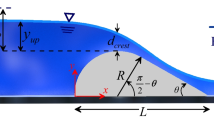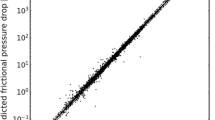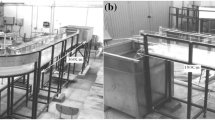Abstract
Due to the complexity of variable distributions, it is essential to evaluate the flow patterns in sharp curved channels with different angles. It has recently become more common to use classification methods in combination with different artificial intelligence (AI) models to boost AI model performance. Gholami et al. (Appl Soft Comput 48:563–583, 2016a) obtained enhanced results by combining two common AI models with a classifier based on decision trees to estimate the flow velocity and flow depth in a 90° sharp curved channel. Their results represent the superior performance and accuracy of hybrid models over classic AI models alone. However, because the diversion angle in intake and bend channels has a considerable influence on the flow variables, the flow patterns differ in 60° and 90° bend channels. Hence, the present paper evaluates the goodness-of-fit results of the classifier multilayer perceptron (CMLP) and classifier radial basis function (CRBF) models designed based on decision trees. These models were designed to estimate the velocity and flow depth patterns in a 60° sharp curved channel based on 780 observational data for six flow rates: 5, 7.8, 13.6, 19.1, 25.3, and 30.6 l/s. According to the mean absolute relative error (MARE) and determination coefficient (R2) results of 0.0514 and 0.6 for velocity and 0.005 and 0.99 for flow depth prediction, the proposed CMLP model is more accurate than the classic MLP model. The CRBF model performed similar to CMLP, whereby CRBF predicted both velocity (MARE 0.086 and R2 = 0.9) and flow depth (MARE 0.0133 and R2 = 0.9) more accurately than the RBF model alone. Overall, the CMLP and CRBF models exhibited MARE reductions of 3% and 20% in velocity prediction and 36% and 22% in flow depth prediction compared to the individual MLP and RBF models, respectively. Moreover, CMLP and CRBF produce robust relationships based on different categories established according to various hydraulic conditions. The uncertainty analysis results show that, among the models examined, CMLP had the lowest uncertainty with the narrowest width of confidence bounds (WCB) of ± 0.1385 and ± 0.0031 in predicting velocity and flow depth, respectively. Moreover, CMLP and CRBF exhibited the greatest reliability with the lowest uncertainty indices in estimating the two flow variables in curved channels compared to the classic MLP and RBF models. Therefore, the combined AI-based classification models proposed in this study can serve as alternatives to the classic MLP and RBF models in the design and construction of curved channels with 60° and 90° bends.





















Similar content being viewed by others
Explore related subjects
Discover the latest articles, news and stories from top researchers in related subjects.References
Akbari M, Vaghefi M (2017) Experimental investigation on streamlines in a 180° sharp bend. Acta Sci Technol 39(4):425–432
Akhtari AA, Abrishami J, Sharifi MB (2009) Experimental investigations water surface characteristics in strongly-curved open channels. J Appl Sci 9(20):3699–3706
Akhtari AA, Seyedashraf O (2018) Experimental and numerical investigation on Vanes’ effects on the flow characteristics in sharp 60° bends. KSCE J Civ Eng 22(4):1484–1495
Anwar HO (1986) Turbulent structure in a river bed. J Hydraul Eng 112:657–669
Araghinejad S, Fayaz N, Hosseini-Moghari SM (2018) Development of a hybrid data driven model for hydrological estimation. Water Resour Manag 1–14
Armfield Limited, Co. (1995) Instruction manual of miniature propeller velocity meter type H33. Armfield Limited, Co, London
Asl PF, Monjezi M, Hamidi JK, Armaghani DJ (2018) Optimization of flyrock and rock fragmentation in the Tajareh limestone mine using metaheuristics method of firefly algorithm. Eng Comput 34(2):241–251
Aydinalp M, Ugursal VI, Fung AS (2002) Modeling of the appliance, lighting, and space-cooling energy consumptions in the residential sector using neural networks. Appl Energy 71(2):87–110
Baghlani A (2012) Application of a high-resolution scheme in simulation of flow in curved channel using boundary-fitted curvilinear coordinates. Sci Iran 19(6):1463–1472
Barbhuiya AK, Talukdar S (2010) Scour and three dimensional turbulent flow fields measured by ADV at a 90° horizontal forced bend in a rectangular channel. Flow Meas Instrum 21:312–321
Bergs MA (1990) Flow processes in a curved alluvial channel. Ph. D. thesis, The University of Iowa
Berry G, Armitage P (1995) Mid-P confidence intervals: a brief review. Statistician 44:417–423
Bilhan O, Emin Emiroglu M, Kisi O (2010) Application of two different neural network techniques to lateral outflow over rectangular side weirs located on a straight channel. Adv Eng Softw 41(6):831–837
Bishop CM (1995) Neural networks for pattern recognition. Oxford University Press Inc, New York
Blanckaert K, Graf WH (2001) Mean flow and turbulence in open channel bend. J Hydraul Eng ASCE 127(10):835–847
Bodnar T, Prihoda J (2006) Numerical simulation of turbulent free-surface flow in curved channel. Flow Turbul Combust 76:429–442
Bonakdari H, Zaji AH (2016) Open channel junction velocity prediction by using a hybrid self-neuron adjustable artificial neural network. Flow Meas Instrum 49:46–51
Booij R (2003) Measurements and large eddy simulations of the flows in some curved flumes. J Turbul 4:8–16
Breiman L, Friedman JH, Olshen RA, Stone CJ (1984) Classification and regression trees. Wadsworth International Group, Belmont
Broomhead DS, Lowe D (1988) Radial basis functions, multi-variable functional interpolation and adaptive networks. Royal Signals and Radar Establishment, Malvern
Chen W, Fu ZJ, Chen CS (2014) Recent advances in radial basis function collocation methods. Springer, Heidelberg
Christopher M (1995) Neural networks for pattern recognition. Oxford University Press, Oxford
Coppersmith D, Hong SJ, Hosking JRM (1999) Partitioning nominal attributes in decision trees. Data Min Knowl Discov 3:197–217
Dawson CW, Wilby RL (2005) Hydrological modeling using artificial neural networks. Prog Phys Geogr 25(1):80–108
DeMarchis M, Napoli E (2006) 3D numerical simulation of curved open channel flows. In: Proceedings of 6th international conference on water resources, hydraulics & hydrology, Chalkida, Evia Island, pp 86–91
DeVriend HJ, Geoldof HJ (1983) Main flow velocity in short river bends. J Hydraul Eng 109:991–1011
Ebtehaj I, Bonakdari H, Zaji AH (2016) A nonlinear simulation method based on a combination of multilayer perceptron and decision trees for predicting non-deposition sediment transport. Water Sci Technol Water Supply 16(5):1198–1206
Fenjan SA, Bonakdari H, Gholami A, Akhtari AA (2016) Flow variables prediction using experimental, computational fluid dynamic and artificial neural network models in a sharp bend. Int J Eng Trans A Basics 29(1):14
Feng G, Huang GB, Lin Q, Gay R (2009) Error minimized extreme learning machine with growth of hidden nodes and incremental learning. IEEE Trans Neural Netw 20(8):1352–1357
Ferguson RI, Parsons DR, Lane SN, Hardy RJ (2003) Flow in meander bends with recirculation at the inner bank. J Water Resour Res 39:1–13
Gerger R, Kisi O, Faruk Dursun O, Emin Emiroglu M (2016) Applicability of several soft computing approaches in modeling oxygen transfer efficiency at baffled chutes. J Irrig Drain Eng 143(5):04016085
Gharde KD, Kothari M, Mittal HK, Singh PK, Dahiphale PA (2015) Sediment yield modelling of Kal river in Maharashtra using artificial neural network model. Res J Recent Sci 4:120–130
Ghasemi E, Kalhori H, Bagherpour R (2016) A new hybrid ANFIS-PSO model for prediction of peak particle velocity due to bench blasting. Eng Comput 32(4):607–614
Gholami A, Akhtari AA, Minatour Y, Bonakdari H, Javadi AA (2014) Experimental and numerical study on velocity fields and water surface profile in a strongly-curved 90° open channel bend. Eng Appl Comput Fluid Mech 8(3):447–461
Gholami A, Bonakdari H, Zaji AH, Akhtari AA, Khodashenas SR (2015) Predicting the velocity field in a 90° open channel bend using a gene expression programming model. Flow Meas Instrum 46:189–192
Gholami A, Bonakdari H, Zaji AH, Akhtari AA (2015) Simulation of open channel bend characteristics using computational fluid dynamics and artificial neural networks. Eng Appl Comput Fluid Mech 9:355–369
Gholami A, Bonakdari H, Zaji AH, Michelson DG, Akhtari AA (2016) Improving the performance of multi-layer perceptron and radial basis function models with a decision tree model to predict flow variables in a sharp 90° bend. Appl Soft Comput 48:563–583
Gholami A, Bonakdari H, Akhtari AA (2016) Assessment of water depth change patterns in 120° sharp bend using numerical model. Water Sci Eng 9(4):336–344
Gholami A, Bonakdari H, Zaji AH, Ajeel Fenjan S, Akhtari AA (2016) Design of modified structure multi-layer perceptron networks based on decision trees for the prediction of flow parameters in 90 open-channel bends. Eng Appl Comput Fluid Mech 10(1):193–208
Gholami A, Bonakdari H, Zaji AH, Fenjan SA, Akhtari AA (2016) New radial basis function network method based on decision trees to predict flow variables in a curved channel. Neural Comput Appl 30(9):2771–2785
Gholami A, Bonakdari H, Akhtari AA (2016) Developing finite volume method (FVM) in numerical simulation of flow pattern in 60° open channel bend. J Appl Res Water Wastewater 3(1):193–200
Gholami A, Bonakdari H, Ebtehaj I, Shaghaghi S, Khoshbin F (2017) Developing an expert group method of data handling system for predicting the geometry of a stable channel with a gravel bed. Earth Surf Process Landf 42(10):1460–1471
Gholami A, Bonakdari H, Ebtehaj I, Akhtari AA (2017) Design of an adaptive neuro-fuzzy computing technique for predicting flow variables in a 90° sharp bend. J Hydroinform jh2017200
Gholami A, Bonakdari H, Ebtehaj I, Gharabaghi B, Khodashenas SR, Talesh SHA, Jamali A (2018) A methodological approach of predicting threshold channel bank profile by multi-objective evolutionary optimization of ANFIS. Eng Geol 239:298–309
Gholami A, Bonakdari H, Zeynoddin M, Ebtehaj I, Gharabaghi B, Khodashenas SR (2018) Reliable method of determining stable threshold channel shape using experimental and gene expression programming techniques. Neural Comput Appl 1–19
Hagan MT, Demuth HB, Mark H, Beale MH (1996) Neural network design. PWS Publishing Company, Boston
Haykin S (1990) Neural networks. A comprehensive foundation, 2nd edn. Prentice-Hall Inc, Englewood Cliffs
Isa IS, Saad Z, Omar S, Osman MK, Ahmad KA, Sakim HM (2010) Suitable MLP network activation functions for breast cancer and thyroid disease detection. In: 2010 second international conference on computational intelligence, modelling and simulation (CIMSiM). IEEE, New York, pp 39–44
Karsoliya S (2012) Approximating number of hidden layer neurons in multiple hidden layer BPNN architecture. Int J Eng Trends Technol 3(6):714–717
Latifoğlu L, Kişi O, Latifoğlu F (2015) Importance of hybrid models for forecasting of hydrological variable. Neural Comput Appl 26(7):1669–1680
Leschziner MA, Rodi W (1979) Calculation of strongly curved open channel flow. J Hydraul Div 105:1297–1314
Levenberg K (1944) A method for the solution of certain nonlinear problems in least-squares. Q Appl Math 2:164–168
Li X, Chan CW (2010) Application of an enhanced decision tree learning approach for prediction of petroleum production. Eng Appl Artif Intell 23(1):102–109
Maier HR, Dandy GC (1999) Empirical comparison of various methods for training feed Forward neural networks for salinity forecasting. Water Resour Res 35(8):2591–2596
Mount NJ, Dawson CW, Abrahart RJ (2013) Legitimizing data-driven models: exemplification of a new data-driven mechanistic modeling framework. Hydrol Earth Syst Sci 17:2827–2843
Naji MA, Ghodsian M, Vaghefi M, Panahpur N (2010) Experimental and numerical simulation of flow in a 90° bend. Flow Meas Instrum 21:292–298
Newcombe RG (1998) Two-sided confidence intervals for the single proportion: comparison of seven methods. Stat Med 17(8):857–872
Nayak SC, Misra BB, Behera HS (2016) Efficient forecasting of financial time-series data with virtual adaptive neuro-fuzzy inference system. Int J Bus Forecast Market Intell 2(4):379–402
Nkiaka E, Nawaz NR, Lovett JC (2016) Using self-organizing maps to infill missing data in hydro-meteorological time series from the Logone catchment, Lake Chad basin. Environ Monit Assess 188(7):400
Oliver N (2001) Nonlinear system identification: from classical approaches to neural networks and fuzzy models. Springer, New York
Parvin H, MirnabiBaboli M, Alinejad-Rokny H (2015) Proposing a classifier ensemble framework based on classifier selection and decision tree. Eng Appl Artif Intell 37:34–42
Poggio T, Girosi F (1990) Regularization algorithms for learning that are equivalent to multilayer networks. Science 247:978–982
Pourgholi R, Tabasi SH, Zeidabadi H (2018) Numerical techniques for solving system of nonlinear inverse problem. Eng Comput 34(3):487–502
Pradhan A (2014) Analysis of flow along the meander path of a highly sinuous rigid channel. Dissertation National Institute of Technology, Rourkela
Ramamurthy A, Han S, Biron P (2013) Three-dimensional simulation parameters for 90° open channel bend flows. J Comput Civ Eng 27:282–291
Rowiński PM, Piotrowski A, Napiórkowski JJ (2005) Are artificial neural network techniques relevant for the estimation of longitudinal dispersion coefficient in rivers? J Hydrol Sci 50:175–187
Rozovskii IL (1961) Flow of water in bends of open channels. Academy of Sciences of the Ukrainian SSR. Israel Program for Science Translation, Kiev, pp 1–233
Saxena A, Saad A (2007) Evolving an artificial neural network classifier for condition monitoring of rotating mechanical systems. Appl Soft Comput 7(1):441–454
Seyedashraf O, Akhtari AA (2017) Three-dimensional CFD study of free-surface flow in a sharply curved 30 open-channel bend. J Eng Sci Technol Rev 10(3):85–89
Shaghaghi S, Bonakdari H, Gholami A, Kisi O, Shiri J, Binns AD, Gharabaghi B (2018) Stable alluvial channel design using evolutionary neural networks. J Hydrol 566:770–782
Tiwari DK, Tiwari HL, Mishra S, Nateriya R (2018) A literature review on ANN based hydrological modeling on Narmada river basin. Int J Innov Adv Comput Sci 74
Ye J, McCorquodale JA (1998) Simulation of curved open channel flows by 3D hydrodynamic model. J Hydraul Eng 124:687–698
Yuhong Z, Wenxin H (2009) Application of artificial neural network to predict the friction factor of open channel flow. Commun Nonlinear Sci Numer Simul 14(5):2373–2378
Wang L, von Laszewski G, Huang F, Dayal J, Frulani T, Fox G (2011) Task scheduling with ANN-based temperature prediction in a data center: a simulation-based study. Eng Comput 27(4):381–391
Zabihi F, Saffarian M (2018) A not-a-knot meshless method with radial basis functions for numerical solutions of Gilson–Pickering equation. Eng Comput 34(1):37–44
Zaji AH, Bonakdari H (2015) Efficient methods for prediction of velocity fields in open channel junctions based on the artificial neural network. Eng Appl Comput Fluid Mech 9(1):220–232
Zaji AH, Bonakdari H, Shamshirband S (2016) Support vector regression for modified oblique side weirs discharge coefficient prediction. Flow Meas Instrum 51:1–7
Zaji AH, Bonakdari H (2018) Velocity field simulation of open-channel junction using artificial intelligence approaches. Iran J Sci Technol Trans Civ Eng 1–12
Zamanlooy B, Mirhassani M (2014) Efficient VLSI implementation of neural networks with hyperbolic tangent activation function. IEEE Trans Very Large Scale Integr VLSI Syst 22(1):39–48
Zeng J, Constantinescu G, Blanckaert K, Weber L (2008) Flow and bathymetry in sharp open-channel bends: experiments and predictions. Water Resourc Res 44(w09401):1–22
Author information
Authors and Affiliations
Corresponding author
Additional information
Publisher’s Note
Springer Nature remains neutral with regard to jurisdictional claims in published maps and institutional affiliations.
Rights and permissions
About this article
Cite this article
Gholami, A., Bonakdari, H., Zaji, A.H. et al. A comparison of artificial intelligence-based classification techniques in predicting flow variables in sharp curved channels. Engineering with Computers 36, 295–324 (2020). https://doi.org/10.1007/s00366-018-00697-7
Received:
Accepted:
Published:
Issue Date:
DOI: https://doi.org/10.1007/s00366-018-00697-7




